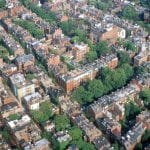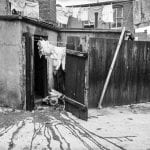Contents
Ecotown Begins Construction in Virginia
Work began in May 1996 on the new ecological town of Haymount, Virginia, near Washington, D.C. Designed by the “new urbanist” firm of Duany & Plater-Zyberk, the community will feature 4,000 housing units in multifamily and single-family homes, 250,000 square feet of retail space, and 500,000 square feet of office or commercial space. Street layout and design will discourage automobile use. Wildlife corridors and open space will cover two-thirds of the 1,700-acre site, and will be protected through conservation easements.
Experts from the Rocky Mountain Institute are assisting the Haymount developers in selecting energy conserving materials and construction practices. The town will feature an innovative ecological wastewater treatment system that uses solar aquatic pools and constructed wetlands to return water to the James River that is cleaner than originally taken for use by the town.
For more information, contact The John Clark Company, 4315 50th St., NW, Washington, D.C. 20016; (202) 362-5088. (Environmental Building News)
Replacing Public Housing
The U.S. Department of Housing and Urban Develoment has begun an eight-year, $2.5 billion effort to improve the nation’s public housing by replacing 100,000 units in high-rise buildings with apartments in a variety of new low-rise buildings. This program expands recent efforts by both cities and the federal government to re-shape the nation’s public housing away from massive high-rise projects — which have often served to ghettoize the poor and increase crime — toward more diverse and decentralized forms of housing.
In Chicago, for example, officials plan to tear down eight of 23 towers in the infamous Cabrini Green public housing development. In their place they envision mixed-income townhouses, condominiums, new schools, parks, a library, a grocery store, and a police station. The 1,300 units lost in the high rises will be replaced by 2,000 housing a greater variety of residents. The controversial project would be partially financed by selling some of the land to private developers. (The New York Times)
Beyond Shelter in Los Angeles
One of the U.S. entries in the Habitat II Best Practices exhibition was Beyond Shelter, a Los Angeles nonprofit that since 1989 has placed more than 750 homeless families in permanent rental housing while also providing education and services. When homeless families are referred to Beyond Shelter, they work with an intake worker to develop an individualized Family Transition Plan which identifies the family’s housing and social service needs and steps necessary to self-sufficiency.
In addition to helping families find rental housing, the program helps them negotiate leases, finance the move, manage money, access medical care, and enter job training and placement programs. Beyond Shelter emphasizes self-help mechanisms to promote independence, and 85 percent of its families are stablized in permanent housing within one year. The organization is also developing more than 200 units of its own service-enriched affordable housing, mainly in Central and South Central Los Angeles.
For more information, contact Beyond Shelter, 4032 Wilshire Boulevard #501, Los Angeles, CA 90010; phone (213) 252-0772; fax (213) 480-0846; email: HN0174@handsnet.org.
Ecological Landscaping in Maryland
A new 569-home development in western Germantown, Maryland contains landscaping features designed to absorb stormwater runoff on site and filter out pollutants.
Instead of curbs and gutters, the Hoyles Mill Village project, designed by Greenhorne & O’Mara, Inc., uses roadside grass swales to capture runoff. Trees, other vegetation, and underground sand filtration basins then remove contaminants and slow the absorption of water into the local watershed, helping reduce erosion and flooding along streams. A main objective is to improve the quality of runoff water entering local creeks, creating better habitat for trout and other fish species downstream. (Urban Land/Greenclips)
Nation’s First Commuter Bike Station
The nation’s first commuter bike station, modeled on similar facilities in the Netherlands and Japan, recently opened in Long Beach, California.
The $150,000 bike center is located at a transit stop on the Metro Blue Line and offers guarded parking for 150 bicycles, bike rentals and repairs, a bike accessorty shop, and a commuter club offering discounts to cyclists. Some 33 miles of bike paths connect to the station. The project was funded through the Intermodal Surface Transportation Efficiency Act (ISTEA), the city of Long Beach, and the Long Beach Redevelopment Agency. (Land Use Digest/Planning)
Energy Efficiency Ratings for New Products
The US Department of Energy and the Environmental Protection Agency will soon offer appliance and building material manufacturers the right to use a Government seal of approval, the Energy Star, if their products meet energy efficiency standards. The two agencies will rank all competing product brands and offer the Energy Star to the top 25 percent.
The Energy Star program will focus on products used in buildings, which account for one-third of the nation’s energy consumption and two-thirds of its electricity use. The logo will be available to manufacturers of the more energy efficient refrigerators, water heaters, air conditioners, thermostats, exit signs, and building materials like insulation.
By federal law, some products already carry stickers describing their energy use and comparing them to competing products, but the complicated guides are hard for consumers to understand. Under the Energy Star program consumers can easily identify the better performers. The agencies are also working with builders on standards for awarding the seal to entire houses. (The New York Times)
Sacramento Traffic Calming
Earlier this year the Sacramento City Council unanimously approved a traffic calming plan that will help protect downtown neighborhoods from the negative effects of through traffic. The Neighborhood Preservation Transportation Plan follows 16 years of policy statements, 75 public community meetings, and several studies by consultants.
The traffic calming policy calls for a number of devices including half street closures to prevent automobile traffic from travelling through established neighborhoods in a straight line. Buses and bikes will be allowed through barriers. The new plan reverses a 1950 decision that converted many downtown routes from two-way streets to three-lane, one-way couplets.
Implementation of the plan will involve a one-year trial period of temporary devices that could be modified if unforseen problems arise. The plan will be monitored by a committee of citizens, businesspersons, and representatives from adjacent neighborhoods. Other nearby areas are apparently anxious to see the plan succeed so that they can be next on the list for traffic calming measures. (California Bike Coalition)
Shorts
A study by Alan Thein Durning at the Seattle-based Northwest Environment Watch finds that higher car use and accident rates pose a greater risk of death or injury to suburbanites than guns, drugs and crime do for urban dwellers. (Los Angeles Times)
In its first year of operation, more than 150 companies, municipalities and nonprofit recyclers have subscribed to the Chicago Board of Trade’s online Recyclables Exchange, and hundreds more have logged onto the system as “view only” users. The oneline system can be accessed at (312) 986-9780. For more information about subscribing, call CBOT at (312) 341-7955. (Interior Concerns Newsletter)
The Rocky Mountain Institute has established a Future 500 roundtable “to help member companies explore and pursue fourfold (or better) increases in resource efficiency as a path to greater profit and competitiveness.” (Environmental Building News)
After installing energy-efficient lighting in its 51-story Manhattan headquarters, the American Express companies has saved 40 percent on electricity bills. (The New York Times)
At least 800 individual homeowners have installed wetlands sewage treatment systems, primarily in the states of Kentucky, Mississippi and Louisiana which have detailed guidelines, while between 400 and 500 communities have built sewage treatment wetlands on a broader scale. (The New York Times)
The Bicycle Coalition of the Delaware Valley has won $3.7 million, 80 percent of which is from federal funds, to develop a signed and mapped network of routes in Philadelphia as well as to install 800 bike racks. (The Tubular Times)
Ashland, Oregon, a town of 20,000 people, is saving 134,000 gallons of water a day as the result of an ambitious water conservation program that is making a $12 million dam unnecessary. The program also saves residents 500,000 kilowatt hours of electricity annually, due to reduced flow showerheads, and lowers the amount of wastewater the city needs to treat by 43 million gallons a year. (Rocky Mountain Institute Newsletter)
The federal Department of Energy has established a Center for Excellence for Sustainable Development, a pilot program to offer technical assistence to help communities become more energy efficient and environmnetally sound. For more information, call (800) 357-7732. (STPP Progress)
In Florida the Governor’s Commission for a Sustainable South Florida has completed a report on the long-term recovery of the area’s natural systems, and the Florida Greenways Commission has issued a report on establishing a statewide greenways system. (The International Green Planner)
Free bike programs — in which old bikes painted distinctive, bright colors are left at central locations for citizens to use and then leave for others — are expanding around the country. Madison, Wisconsin’s program features bright red bikes, Boulder uses bright green paint, and Portland’s 200 bikes are painted bright yellow. In Fresno, California the Rotary Club has distributed several hundred yellow bikes around the city. (AP; San Ramon Valley Times)
In Boston’s Post Office Square, revenues from parking fees pay the operating costs of a combination 1.7 acre street-level park and underground garage. (GreenSense)







